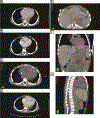Patterns of recurrence after radiotherapy for high-risk neuroblastoma: Implications for radiation dose and field
- PMID: 38880415
- PMCID: PMC12255944
- DOI: 10.1016/j.radonc.2024.110384
Patterns of recurrence after radiotherapy for high-risk neuroblastoma: Implications for radiation dose and field
Abstract
Background: Prognosis for patients with high-risk neuroblastoma (HR-NBL) is guarded despite aggressive therapy, and few studies have characterized outcomes after radiotherapy in relation to radiation treatment fields.
Methods: Multi-institutional retrospective cohort of 293 patients with HR-NBL who received autologous stem cell transplant (ASCT) and EBRT between 1997-2021. LRR was defined as recurrence at the primary site or within one nodal echelon beyond disease present at diagnosis. Follow-up was defined from the end of EBRT. Event-free survival (EFS) and OS were analyzed by Kaplan-Meier method. Cumulative incidence of locoregional progression (CILP) was analyzed using competing risks of distant-only relapse and death with Gray's test.
Results: Median follow-up was 7.0 years (range: 0.01-22.4). Five-year CILP, EFS, and OS were 11.9 %, 65.2 %, and 77.5 %, respectively. Of the 31 patients with LRR and imaging review, 15 (48.4 %) had in-field recurrences (>12 Gy), 6 (19.4 %) had marginal failures (≤12 Gy), and 10 (32.3 %) had both in-field and marginal recurrences. No patients receiving total body irradiation (12 Gy) experienced marginal-only failures (p = 0.069). On multivariable analyses, MYCN amplification had higher risk of LRR (HR: 2.42, 95 % CI: 1.06-5.50, p = 0.035) and post-consolidation isotretinoin and anti-GD2 antibody therapy (HR: 0.42, 95 % CI: 0.19-0.94, p = 0.035) had lower risk of LRR.
Conclusions: Despite EBRT, LRR remains a contributor to treatment failure in HR-NBL with approximately half of LRRs including a component of marginal failure. Future prospective studies are needed to explore whether radiation fields and doses should be defined based on molecular features such as MYCN amplification, and/or response to chemotherapy.
Keywords: Autologous stem cell therapy; Dinutuximab; MYCN amplification; Photon radiotherapy; Proton radiotherapy; Total body irradiation.
Copyright © 2024 Elsevier B.V. All rights reserved.
Conflict of interest statement
Declaration of competing interest The authors declare the following financial interests/personal relationships which may be considered as potential competing interests: SGD has received travel expenses from Loxo, Roche, and Salarius and consulting fees from Amgen, Bayer, and Jazz. TIY receives in-kind software support from MIM software to support a multicenter pediatric registry. Prior Presentation: Presented in part at the 64th Annual Meeting of the American Society for Radiation Oncology, San Antonio, TX, October 23–26, 2022.
Figures



References
-
- Matthay KK, Maris JM, Schleiermacher G, Nakagawara A, Mackall CL, Diller L, et al. Neuroblastoma. Nat Rev Dis Primers. 2016;2:16078. - PubMed
Publication types
MeSH terms
Grants and funding
LinkOut - more resources
Full Text Sources
Medical

